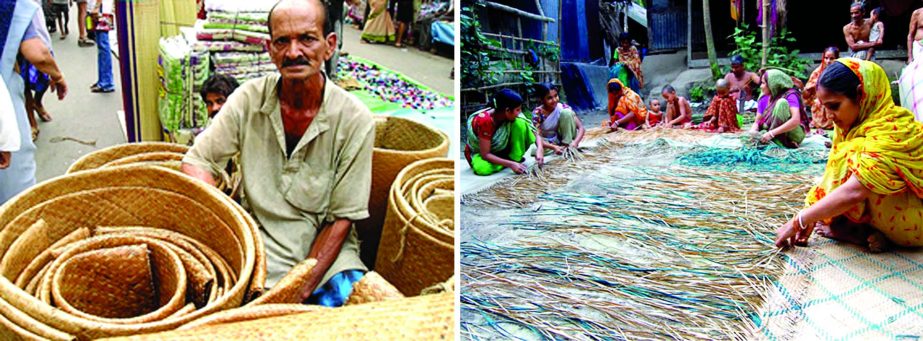
UNB, Sylhet :
The world famous Shital Pati (cool mat made of cane) industry is facing a downturn in production due to unavailability of Murtar, one kind of rattan used in mat-making, in the country.
Talking to UNB, a number of mat makers said once Shital Pati of Sylhet was very popular both at home and aboard and making the item was a means of livelihood for thousands of people at that time.
Despite rising demand of the mat, the industry is on verge of extinction for various reasons, including unavailability of Murtar.
They said earlier thousands of people of many villages, including Teghoria, Chanpurom Shrinathpur, Atasion, Gouripur, Lohamora, Khujgipur, Koergaon, Harisham, Kalampur and Algapur in Balaganj upazila, were involved in mat-making profession.
Though the item was made in different other areas of Sylhet, Shital Pati of Balaganj was very popular at home and aboard.
It had good position both in local and international markets and was exported to England, France and Russia.
It is said that Shital Pati of Balaganj got place at the palace of Queen Victoria during the British period.
Thus, Balaganj mat makers earned name and fame across the world in exchange of their products.
For Shital Pati, Jaduram Das of Balaganj won gold medal at craft exhibition in Kolkata in 1906 as the best craftsman.
Manindnath of the upazila also received award at Crafts Exhibition held in Rome in 1991.
Besides, for Shital Pati, Pabanjoy Das of Balaganj was awarded as the best craftsman at the national level in 1982.
Abul Kalam, a mat maker of Kalampur village in Balaganj, said the industry developed in Sylhet as its weather and soil mostly suited cultivation of Murtar, the key material of mat.
It takes three years for Murtar to grow fully, he added.
He said there are different types of mats namely Siki, Adhuli, Taka, Sonamuri, Nayantara and Asmantara.
In most cases, the imposition of their names depends on size.
For preparing a mat, Abul Kalam said it may take three to four months for a skilled artisan and the prepared mat can be sold at prices ranging from Tk 2,000 to 8,000.
The mat-maker said they are now facing problems in preparing Shital Pati for lack of Murtar.
Mentioning that Murtar was available in the country till 90s in the last century, another mat maker Jamal Uddin said with the rise in population, people started setting up houses in the fields where Murtar trees grew.
As a result, the number of Murtar gardens decreased, he said.
He fears that though Murtar gardens are still found in different places of Sylhet region, that’s not enough to sustain the Shital Pati industry.
Sharing their problems with this correspondent, he said they are struggling to survive, adding that a number of them are leaving their profession and looking for alternatives.
The mat-makers spoke about commercial cultivation of Murtar and urged the government to provide loan to them to revive the industry.
“Only government’s patronisation can save the industry from extinction. If it’s not done, Shital Pati will be found nowhere except museum,” they said.

